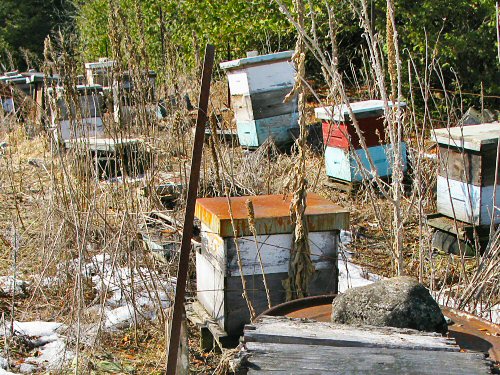
There’s an apparently abandoned bee village on the edge of the tree-enclosed clearing just beyond the main field (the clearing is past the fence, covered in snow, in this pic). There is a backstory here, still to be fully figured out, but the basic fact of the moment is a forlorn, ghost town-looking double row of hives, maybe 15 in all. I don’t know anything about beekeeping, so I did a little research. These seem to be the standard Langstroth hive design, used all over the world. From the photos I saw, the set-up here looks pretty normal, except for the tilting, the worn out paint, and the solidly rusted electric fence that surrounds them. Sorting this out is something new to do this spring. Our future in bees…




Are you sure they are abandoned?
In my country (Greece) you can find “bee villages” like this one in many areas. Maybe it’s good to wait 1-2 months before you do anything.
How fortunate! We have considered starting a bee colony but haven’t wanted to spend on that project yet. In the interim, we’re buying Orchard Mason Bees and nests.
Wow, there’s a lot of equipment there! What a nice bonus to find at your new place!
Annie
OH, that’s very sad. They may not be abandoned (most of the ones around here look like that and they have landlords).
We’re getting bees this year. Can’t wait! If you want a few good reads on beekeeping check out: Keeping Bees and Making Honey and Natural Beekeeping (both are great!).
I was just reading someone else’s blog, and they have electric fence to keep the bears out of the hives. Do you think that is what your fence was for?
http://theslowcook.blogspot.com/2009/03/farmers-new-bees.html
Fabulous, oh do it, I would love to see the bee village back in action! I love honey and wanted to make my own but we aren’t allowed any livestock on our Lottie :( councils can be spoil sports. But the main cost is the housing and you have it all there – so lucky!
Just be careful in using old equipment. You want to get off to a good start.
Keeping bees is one of the most enjoyable things ever! I have been learning -shadowing three local beekeepers here in MT for the last 3 years, and this year I am off on my own with 5 hives. Cheers to you and your future in beekeeping!
A Second on reusing old equipment! There are several pests that prey on bees contributing to their decline right now, and they can live on in abandoned hives. Check your local area for a bee keepers association to get some expert advice.
I would find a local beekeeping group by running an ass in the paper. They are so helpful, and can ussually get bees cheaper then commercial guys will sell them for. They also have great advice.
What a great find! My husband worked as a bee keeper for a couple different local businesses, and we can’t wait to do it ourselves.
I second concerns about using old equipment. Make sure you know how to disinfect and when it would be better to burn the lot.
What a great find on your property! Beekeeping equipment (new and used) is expensive. As a beekeeper, I agree with the others comments – you need to make sure the equipment is safe to use. If you’re interested in becoming a beekeeper, try to find a mentor or a beekeeping group – they would offer a wealth of information. Good Luck.
If, in fact, there aren’t any live bees in the equipment, then there aren’t any pest concerns when it comes to using the old equipment, and the only disease concern to worry about is American foulbrood. Unfortunately, the only good way to disinfect equipment with American foulbrood is burning (or perhaps some very non-organic, expensive, high-tech methods like irradiation), and American foulbrood is a serious enough disease to warrant burning, but it’s also not all that common. My thinking would be to find a way to get some bees in the equipment while spending/investing as little money as possible. Once you get the bees started, I would inspect them at least every other month of the growing season — learn as best as you can to recognize the different signs and stages of AFB (American foulbrood). After two or three years of no disease showing up, I would feel comfortable co-mingling the old equipment with new, expensive, disease-free equipment as needed. I would try to keep my investment in new equipment/bees low enough that I wouldn’t have too much to lose if it became necessary to set it all on fire. Have fun! I second the recommendation to read some good beekeeping books.
i found this site by googling ‘how to reuse abandoned bee hive’ … i had bees for one season [northeast ohio] and the second season which was 2008, evidently the bees ‘swarmed’ because i didn’t know about bees instinct to leave the hive because of ‘over-crowding’ it is now late april 09 and i want to beekeep again… i opened the hive and it is disgusting but the panels seem full of honey but there are cobwebs and what looks like something moths left behind. does anyone know, if a can get a box of bees, of course with a queen, and start the hive over again… someone told me that new bees would ‘clean up’ the hive… is that true? please help!